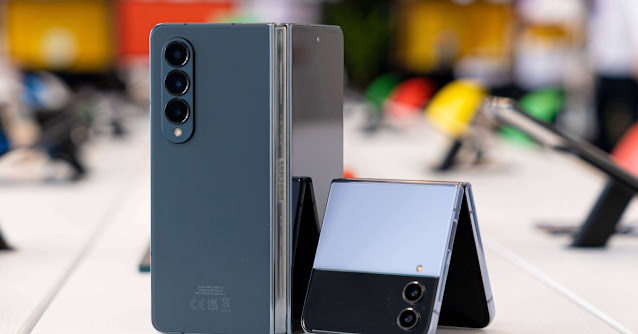While the Samsung Galaxy Z Fold4 and Z Flip4 may resemble their predecessors in appearance, they provide a number of significant changes.
Making the foldable a regular smartphone that you didn't have to watch over and guard was the main goal of last year. By making the Galaxy Z Fold3 compatible with the S Pen and water-proofing its foldables to the IPX8 standard (resistance to water for up to 30 minutes in as much as 1.5 metres of freshwater), Samsung accomplished two significant technological advances that will make folding phones stand out even in 2022. To ensure they perform better over time, Samsung also strengthened the hinge and overall architecture.
The focus this year is on modernising the cameras in Samsung's foldable devices. The Flip3 was left with a 12MP sensor we first saw back on the infamous Galaxy Note7 in 2016; this makes the Flip3 an ancient smartphone in comparison to this year's Galaxy Z Fold3 which has a 12MP main camera dating back to the Galaxy S20 from 2020. Samsung made the proper decision this year and significantly updated both sets of cameras.
The 10MP 3x zoom sensor from the Galaxy S22 series is now included in the Galaxy Z Fold4 together with the 50MP main camera. Sadly, the ultrawide still has fixed focus. The primary camera on the Galaxy Z Flip4 is a 12MP 1/1.76" sensor with 1.8m pixels (up from 1.4m on the Flip3), which results in a 65% improvement in light-gathering. Although there is no telephoto and the ultrawide has fixed focus, this year's arrangement is still far more capable than last year's.
The Galaxy Z Flip4's battery is probably an enhancement that is similarly significant. Samsung claims that the 3,700mAh increase allows it to stream videos for an additional three hours. Even better, the Galaxy Z Flip4 received a much-needed speed boost in charging; instead of the meagre 15W of its predecessor, the phone now peaks off at 25W.
Samsung Galaxy Z Fold4 specs at a glance:
- Body: 155.1x130.0x6.3mm, 263g; Glass front (Gorilla Glass Victus+) (folded), plastic front (unfolded), glass back (Gorilla Glass Victus+), aluminum frame; IPX8 water resistant (up to 1.5m for 30 mins), Armour aluminum frame with tougher drop and scratch resistance (advertised), Stylus support.
- Display: 7.60" Foldable Dynamic AMOLED 2X, 120Hz, HDR10+, 1200 nits (peak), 1812x2176px resolution, 10.81:9 aspect ratio, 373ppi; Cover display:, Dynamic AMOLED 2X, 120Hz, Corning Gorilla Glass Victus+, 6.2 inches, 904 x 2316 pixels, 23.1:9 ratio.
- Chipset: Qualcomm SM8475 Snapdragon 8+ Gen 1 (4 nm): Octa-core (1x3.19 GHz Cortex-X2 & 3x2.75 GHz Cortex-A710 & 4x1.80 GHz Cortex-A510); Adreno 670.
- Memory: 256GB 12GB RAM, 512GB 12GB RAM, 1TB 12GB RAM; UFS 3.1.
- OS/Software: Android 12L, One UI 4.1.1.
- Rear camera: Wide (main): 50 MP, f/1.8, 24mm, 1.0µm, Dual Pixel PDAF, OIS; Telephoto: 10 MP, f/2.4, 67mm, 1.0µm, PDAF, OIS, 3x optical zoom; Ultra wide angle: 12 MP, f/2.2, 123˚, 12mm, 1.12µm.
- Front camera: Inner under-display camera: 4 MP, f/1.8, 26mm, 2.0µm; Cover camera: 10 MP, f/2.2, 24mm, 1/3", 1.22µm.
- Video capture: Rear camera: 4K@60fps, 1080p@60/240fps (gyro-EIS), 720p@960fps (gyro-EIS), HDR10+; Front camera: 4K@30fps, 1080p@30fps, gyro-EIS.
- Battery: 4400mAh; Fast charging 25W, 50% in 30 min (advertised), Fast wireless charging 15W, Reverse wireless charging 4.5W.
- Misc: Fingerprint reader (side-mounted); NFC; stereo speakers; Bixby natural language commands and dictation, Samsung DeX (desktop experience support), Samsung Pay (Visa, MasterCard certified), Ultra Wideband (UWB) support.
Samsung Galaxy Z Flip4 specs at a glance:
- Body: 165.2x71.9x6.9mm, 187g; Plastic front (opened), glass back (Gorilla Glass Victus+), aluminum frame; IPX8 water resistant (up to 1.5m for 30 mins), Armour aluminum frame with tougher drop and scratch resistance (advertised).
- Display: 6.70" Foldable Dynamic AMOLED 2X, 120Hz, HDR10+, 1200 nits (peak), 1080x2640px resolution, 22:9 aspect ratio, 426ppi; Cover display: Super AMOLED, 1.9 inches, 260 x 512 pixels (Gorilla Glass Victus+).
- Chipset: Qualcomm SM8475 Snapdragon 8+ Gen 1 (4 nm): Octa-core (1x3.19 GHz Cortex-X2 & 3x2.75 GHz Cortex-A710 & 4x1.80 GHz Cortex-A510); Adreno 730.
- Memory: 128GB 8GB RAM, 256GB 8GB RAM, 512GB 8GB RAM; UFS 3.1.
- OS/Software: Android 12, One UI 4.1.1.
- Rear camera: Wide (main): 12 MP, f/1.8, 24mm, 1.8µm, Dual Pixel PDAF, OIS; Ultra wide angle: 12 MP, f/2.2, 123˚, 1.12µm.
- Front camera: 10 MP, f/2.4, 26mm (wide), 1.22µm.
- Video capture: Rear camera: 4K@30/60fps, 1080p@60/240fps, 720p@960fps, HDR10+; Front camera: 4K@30fps.
- Battery: 3700mAh; Fast charging 25W, 50% in 30 min (advertised), Fast wireless charging 15W, Reverse wireless charging 4.5W.
- Misc: Fingerprint reader (side-mounted); NFC; stereo speakers; Samsung Pay (Visa, MasterCard certified).
While many had anticipated for a further greater reduction, the Galaxy Z Fold4 is likewise 3.1mm smaller than its predecessor. This is undoubtedly a positive move in the right direction.
The Galaxy Z Flip4 also became leaner; the frame is flatter, the hinge is 1.2mm thinner, and the phone is 1.5mm shorter when closed, all of which helped make room for the larger battery. The cover display of the Galaxy Z Flip4 generally remained the same, however the main display also received a bezel reduction.
This year, Samsung improved both of its foldables in significant ways. Enhancements to battery life and the camera are nice, especially now that most other issues have been resolved. The only other folding phones in the market, which are limited to limited manufacturing China-only models, are the Galaxy Z Fold4 and Z Flip4.


.jpg)
.jpg)
.jpg)
.jpg)
.jpg)
